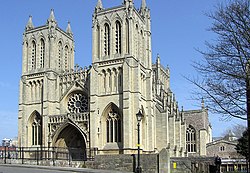User:Sapphire/Sandbox
 |
 |
| The Cathedral Church of the Holy and Undivided Trinity Bristol Cathedral | |
|---|---|
 The Abbey of Saint Augustine was the first building on the site, begun in 1140. In 1542 the abbey was declared a cathedral by Henry VIII | |
| Religion | |
| District | Diocese of Bristol |
| Ecclesiastical or organizational status | Cathedral |
| Location | |
| Location | Bristol, England |
| Architecture | |
| Architect(s) | Robert Fitzhardinge, David Abbott, George Edmund Street, and J.L. Pearson |
| Length | 91.4 meters |
| Website | |
| Bristol Cathedral Website | |
The Cathedral Church of the Holy and Undivided Trinity (grid reference ST583727) is the Anglican cathedral in the English city of Bristol and is commonly known as Bristol Cathedral.
Bristol Cathedral was founded as St Augustine's Abbey in 1140 by Robert Fitzharding, a wealthy local landowner and royal official. As the name suggests, it was intended to house Augustinian canons. Stone buildings were gradually erected over the rest of the century. Two fine examples of this Norman phase survive: the chapterhouse and the abbey gatehouse, together with a second Romanesque gateway, which originally led into the abbot's quarters.[1]
Under Abbot David (1216-1234) there was a new phase of building, notably the construction of the Elder Lady Chapel in around 1220. The eastern part of the abbey church was rebuilt in the English Decorated style between 1298 and 1332 under Abbot Edward Knowle. Abbot John Newland (1481-1515) began the rebuilding of the nave, but it was still incomplete at the Dissolution of the Monasteries in 1539 and the partly-built nave was demolished. In 1542 the church was made the cathedral of a new Diocese of Bristol and was dedicated to the Holy and Undivided Trinity.[2]
A new nave was added during the 19th century, designed by George Edmund Street to blend in style with the medieval east end. The opening ceremony was on 23 October 1877. However the west front with its twin towers was only completed in 1888.[3] It is a "hall church" with nave, aisles and choir all at the same height, and the most significant example of a hall church in Britain. It is a grade I listed building.
The Norman abbey gatehouse is now the diocesan office.
| Total length, external | 300 ft | 91.4 m |
| Total Length, internal | 284 ft | 87 m |
| Length of nave | 125 ft | 38 m |
| Width, including aisles | 69 ft | 21 m |
| Length of transept | 115 ft | 35 m |
| Width of transept | 29 ft | 9 m |
| Height to vault in nave | 52 ft | 16 m |
| Height to vault in choir | 50 ft | 15 m |
| Area | 22,556 ft² | 2096 m² |
Bristol is also home to a Roman Catholic cathedral, Clifton Cathedral. The Anglican parish church of St. Mary Redcliffe is so grand as to be occasionally mistaken for a cathedral by visitors.
Trivia[edit]
- Bristol Cathedral was used as a location in the 1978 film The Medusa Touch under the guise of a fictional London place of worship called Minster Cathedral. [1]
Notes[edit]
- ^ Joseph Bettey, St Augustine's Abbey, Bristol (Bristol Branch of the Historical Association 1996), pp.1, 5, 7.
- ^ Joseph Bettey, St Augustine's Abbey, Bristol (Bristol Branch of the Historical Association 1996), pp.7, 11-15, 21, 24-5.
- ^ Joseph Bettey, Bristol Cathedral: The rebuilding of the nave (Bristol Branch of the Historical Association 1993).
External links[edit]
- Diocese of Bristol
- Bristol Past: The Abbey Gatehouse
- A history of Bristol Cathedral choir school and choristers
- Bristol Cathedral Independent article and pictures of the Cathedral in Bristol
